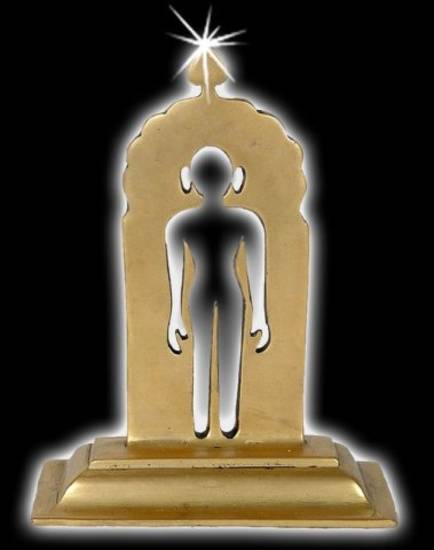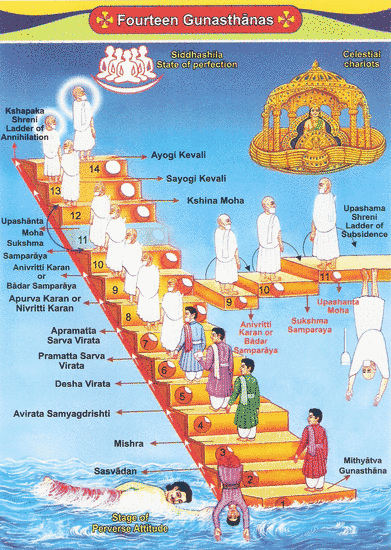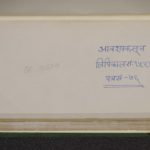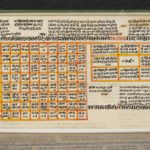Article: Jain Beliefs
The fundamental aim of the Jain faith is to perfect the soul, which can be done only by following the teachings of the Jinas. Jains believe that the 24 Jinas revealed the essential truths of the universe and provided guidance to reaching liberation from the cycle of rebirth.
The teachings of the most recent Jina, Mahāvīra, were set down in the scriptures, which state the principal concepts Jains should believe and by which they should live. Over the centuries teachers and thinkers have written extensively on Jain beliefs and the rules of living that support them. Living according to these rules, whether mendicant or lay, puts religious principles into practice and helps Jains develop spiritually and eventually gain emancipation.
The most basic beliefs are the seven or nine tattvas, which comprise the universe. Accepting these fundamental concepts is the definition of a Jain believer. These principles are the bedrock of further Jain beliefs, such as the soul, karma and knowledge. The Jain notion of the soul or self – jīva – is unique. Spiritual fulfilment to Jains is the return of the soul to its original purity, free of the karmas that trap it in the cycle of rebirth. Karma clouds the inherent, bright purity of the soul, sticking to and permeating it, weighing it down. The 14 stages of the ‘scale of perfection’ – guṇa-sthāna – chart the soul’s progress in ridding itself of karmas and developing spiritually. The soul’s spiritual level can also be seen in the leśyā staining it particular colours.
Knowledge is needed to recognise the delusions of the world, with omniscience or absolute knowledge the highest type of knowledge. The salvation of the soul – mokṣa – comes after omniscience, when there are no karmas bound to it. The road to emancipation from the cycle of births is long and difficult, lasting numberless lifetimes. The karma attached to a soul means it is reborn in different lives, a cyclical process that lasts for aeons until the soul is free of all karma. In each lifetime the soul exists in a different type of body, depending on the karma it has accrued in previous lifetimes, which are generated by behaviour and mental attitudes. The conviction that life pervades the universe and is interconnected underlies the most famous Jain principle of ahiṃsā – non-violence. Observing this tenet explains many Jain practices.
All attachments to things of the world create karmas, which hinder the soul’s attributes. Monks and nuns aim to achieve complete detachment, which is made easier by renouncing the world. Making vows of renunciation also aids the self-awareness and detachment of an ideal Jain follower. The various types of vows are an important part of religious practice because they are a kind of asceticism, which burns karma. Mendicants take five ‘great vows’ – māha-vratas – while the laity can take the aṇu-vratas – ‘lesser vows’. These are limited versions of the mendicant vows, tailored to work within the lay lifestyle.
The concept of the ‘three gems’ – ratna-traya – summarises Jain doctrine, grouping it into three elements. Karma is gradually destroyed and spirituality grows from following the three principles, ultimately resulting in liberation. The jewels provide the starting point for other Jain principles and beliefs and their associated practices. The quality of ‘right asceticism’ – tapas – is often dubbed the ‘fourth gem’, reflecting the crucial part of ascetic practices within Jainism.
The two main, related notions in Jain philosophy are anekānta-vāda and syād-vāda. Jains believe that reality has many aspects and the term anekānta-vāda means that it cannot be understood from just one angle. The term can be translated as the doctrine of ‘truth from many viewpoints’ or ‘non-one-sidedness’. The concept of syād-vāda is frequently rendered as the doctrine of ‘qualified assertion’ or ‘assertion of possibilities’ and means that any assertion or statement about something is true only in those specific circumstances. Thus it implies that generalising is unwise because all situations are unique, even though the differences may be subtle. Overall, Jain philosophy suggests that human beings can understand the complex truth of reality only to a limited degree. Nothing is absolute and final, and different viewpoints may be equally valid and accurate, because they come from differing perspectives. Jains believe that full understanding of reality arrives only with the attainment of perfect knowledge, which is part of enlightenment.
Even though it is an ancient religion, Jainism may be considered in modern scientific terms. Traditional Jain beliefs can also be presented as four ‘Noble Truths’. The first three lay out principles that may be called the ‘science of the soul’ while the last describes how Jain beliefs and practices lead to liberation.
Jain beliefs offer a contrast to the Western scientific method. True understanding of self and reality are central to the Jain journey towards liberation. Traditionally, Jains do not distinguish between scientific and other types of knowledge, considering the world as a complex, interconnected whole. Western thought has developed by specialising in certain areas, with the break between science and other forms of knowledge particularly marked. However, viewing the world holistically is an emerging trend in scientific thought. It increasingly acknowledges that reality is an extremely convoluted web of relationships, which can most fruitfully be approached from many different perspectives. This is one way Jain traditions continue to be relevant in the 21st century.
‘Fundamentals of existence’
Becoming a follower of the Jinas involves accepting and understanding the proper view of reality, which they taught. All other Jain beliefs stem from these seven ‘fundamentals of existence’ – tattvas. These are:
- the sentience of the soul, which is found in many physical forms – jīva
- that some things do not have souls – ajīva
- influx of karma to the soul – āsrava
- binding of karma to the soul – bandha
- stopping the influx of karma – saṃvara
- separating existing karma from the soul – nirjarā
- liberation of the soul – mokṣa.
The seven tattvas are described in the Tattvārtha-sūtra, the key statement of Jain principles that is accepted as the basic religious text by all Jain sects.
Two more tattvas are often added, namely:
These nine principles are analysed in detail in the Navatattva-prakaraṇas. Available in shorter and longer recensions, these are among the works that form the basis of the monastic curriculum.
Soul
The Jain faith revolves around the notion of the soul – jīva. The ultimate objective of the Jain religion is for the soul to attain self-realisation, which is liberation.
The soul is a concept found in many religions but Jain beliefs about the soul or self are very distinctive. In Jain cosmology the soul is a pure substance with:
The soul always has these qualities – guṇas – and others, regardless of the body it inhabits.
Souls are found within many types of living beings, ranging from those with one sense to those with five. A soul contracts or expands to fill the available space inside a body, from a tiny, one-celled nigoda to a five-sensed blue whale.
The soul is a non-material substance – dravya – and there are infinite numbers of individual souls. They are all bound in the cycle of rebirth – saṃsāra – by the karma generated by the bodies within which they exist, until they are liberated from flesh and ascend to the siddha-śilā. There, at the top of the universe, all the siddhas – liberated, disembodied, perfect souls – exist in permanent bliss.
The opposite of jīva is ajīva, which can be described as the absence of soul. Ajīva is found in non-living things. Both forms of matter make up the universe, according to Jain cosmology.
Karma
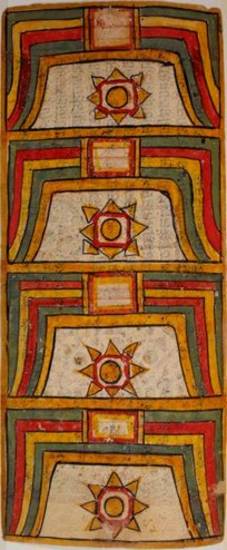
Structure of four hells
Image by British Library © CC0 1.0 (Creative Commons Public Domain)
Another key Jain belief is karma. The soul is trapped in the cycle of rebirth – saṃsāra – by karma. In the cycle of births, the soul – jīva – is born into many different types of body – kāya – each with attachments to its world, including passions or emotions. Thoughts, speech and action create different types of karman or karma, which are bound to the soul, weighing it down and obscuring its shining brightness. To regain its original pure condition, the soul must rid itself of karma by progressing spiritually.
The concept of karma is found in other religions that originated in the Indian subcontinent, such as Buddhism and Hinduism. However, the Jain notion of karma is unique, as it is considered a physical material that gets stuck to the soul. It is a type of pudgala – highly subtle matter – that is insentient.
Karma is a highly complex notion for Jains, with 148 kinds grouped into eight main categories – the mūla-prakṛtis – each of which has different effects. These eight categories are classified into the uttara-prakṛtis. Each type of karma is defined by elements, such as duration, intensity and quantity, and presents different aspects.
The various types of karma influence different elements of a birth and future births. For example the lifespan of a living being is determined by its āyus-karma.
‘Scales of perfection’
The ‘scale of perfection’ – guṇa-sthāna – is a way of guiding human beings gradually towards liberation. As people follow the beliefs and practices associated with each of the 14 successive stages, they advance spiritually.
To advance to the sixth stage, Jains must become mendicants. The gulf between the lay and mendicant lifestyle is so big that there is another step-by-step framework to help lay people become monks or nuns. The 11 levels of the pratimā enable lay Jains to live more like mendicants in stages, although they can decide not to progress further.
As it travels up the ‘scale of perfection’, the soul reaches levels of spiritual development where it destroys its bound karma and stops new karma from sticking to it. It can thus attain, in stages, absolute knowledge – kevala-jñāna – and finally liberation, which means the soul is freed of all karma and is perfected once again. Spiritual development requires that the human within which the soul is embodied for this lifetime accepts Jain principles and undertakes practices that reduce karma.
Leśyā
A soul’s level of spiritual development can be gauged by its leśyā. This is a staining of the soul a certain colour. The soul‘s leśyā takes various colours, with certain colours indicating spiritual level.
A perfect soul has no karmas, so its inherent purity and clarity can be seen. As a soul develops spiritually, it gets lighter and brighter.
Knowledge
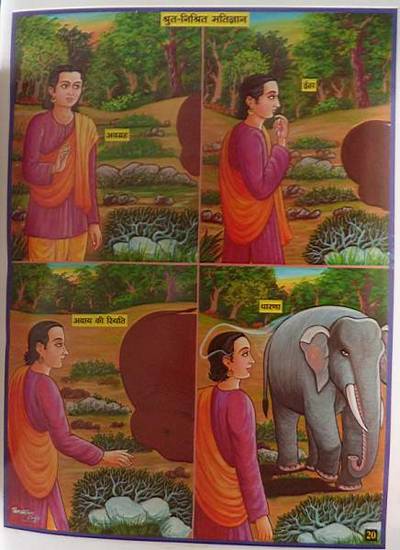
Stages of knowledge
Image by Diwakar Prakashan / Padma Prakashan © Diwakar Prakashan / Padma Prakashan
There are five types of knowledge – jñāna – in traditional Jain thought, namely:
- mind-based and sensory knowledge – mati-jñāna
- scriptural knowledge – śruta-jñāna
- extra-sensory knowledge or clairvoyance – avadhi-jñāna
- knowledge of others’ minds or telepathy – manaḥparyāya-jñāna
- omniscience or absolute knowledge – kevala-jñāna.
Knowledge is a fundamental element of the quest for spiritual progress. As a soul develops spiritually, freeing itself of karma, it acquires greater knowledge, until it accomplishes perfect knowledge – kevala-jñāna. This is achieved solely at the highest spiritual levels, shortly before final emancipation – mokṣa.
Thus a soul can gain the different types of knowledge with spiritual progress. But knowledge is also a way to advance spiritually, because the correct view of reality is the first, basic step in spiritual progression. Accepting the teachings of the Jinas is the first of the three jewels while the second is ‘correct knowledge’ or ‘proper knowledge’ – samyag-jñāna. It means grasping properly the fundamental truths, as revealed by the Jinas.
Omniscience
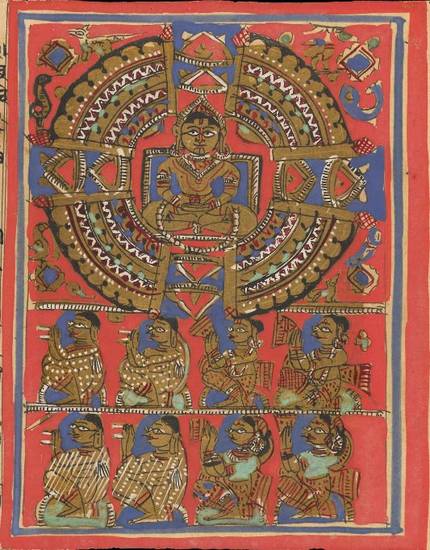
Universal gathering and fourfold community
Image by British Library © CC0 1.0 (Creative Commons Public Domain)
Absolute knowledge – kevala-jñāna – is omniscience or enlightenment and is a prerequisite to achieving liberation. Absolute or perfect knowledge is the highest of the five different types. An omniscient person knows everything that ever happened, is happening or will happen in all parts of the universe.
The hardest type of knowledge to achieve, enlightenment occurs in the 13th stage of spiritual purity in the guṇa-sthāna. All karma is destroyed when reaching omniscience so an omniscient individual becomes liberated – mokṣa – on death.
Someone who is enlightened is called a kevalin. All Jinas attain omniscience before reaching mokṣa but not all kevalins are Jinas. Kevalins do not teach others whereas each Jina founds a fourfold community of lay men, lay women, monks and nuns, and preaches the way to achieve salvation.
Digambaras believe that only men can attain omniscience but Śvetāmbaras believe that both men and women can become enlightened.
Liberation
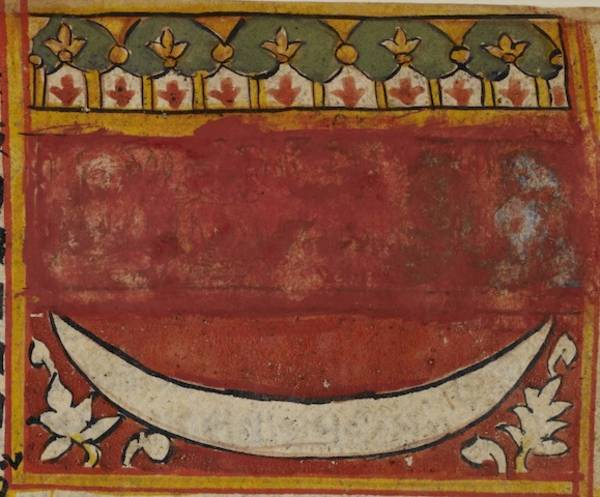
Home of liberated souls
Image by British Library © CC0 1.0 (Creative Commons Public Domain)
Liberation means the freeing of the soul from the cycle of birth – mokṣa – so it regains its original purity. On the death of the body in which it dwells, instead of being born into another body the liberated soul – siddha – flies up to the siddha-śilā. At the apex of the universe, this is where all the liberated souls exist as separate perfect beings in permanent ecstasy.
When it experiences mokṣa the soul is liberated from flesh and is perfected. Emancipation is also known as nirvāṇa. This is the ultimate goal of the Jain religion.
Humans are the only beings that can be liberated but not all humans are considered capable of reaching emancipation. Only perfect mendicants can develop spiritually enough to reach salvation because they achieve complete detachment, which reduces karma. Such detachment is impossible for lay people, who must live in the world and take part in life in the family and community, to varying degrees. This is why only mendicants, who leave behind the householder life, can move towards liberation.
The question of whether women can attain mokṣa is answered differently in the various Jain sects. The Digambara tradition holds that women cannot reach emancipation because they can never achieve the total detachment that is necessary. In contrast, the Śvetāmbara sects assert that women can accomplish salvation.
Cycle of birth
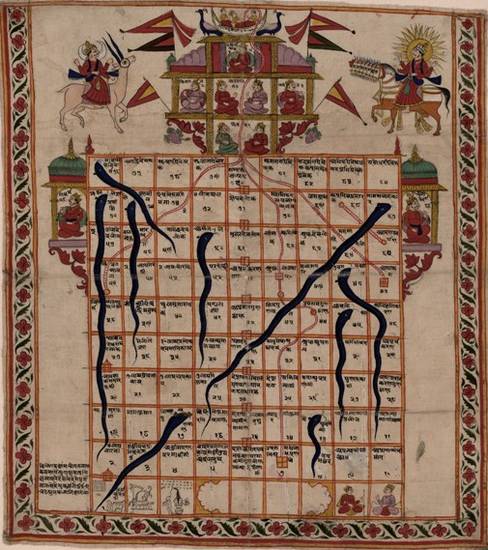
Snakes and ladders
Image by Victoria and Albert Museum © V&A Images/Victoria and Albert Museum, London
One of the principal Jain beliefs is that an unliberated soul exists within the physical form of one body, dies and is then born in another life and body. This process continues until the soul has rid itself of all karma. Only then is it liberated from the cycle of births – saṃsāra – which is often referred to as the ocean of rebirth. Jinas are often described as Tīrthaṃkaras or ford-makers, who cross the ocean of rebirth to liberation – mokṣa – and create a ford for others to follow them.
The body and life into which a soul is born vary depending on the karma it has accumulated in previous lives. Only those souls that reduce their karma by practising austerities – tapas – can develop spiritually enough to progress up the scale of perfection – guṇa-sthāna. Over many many lifetimes, souls gradually reach the top of the scale and are then liberated from the cycle of rebirth.
Behaving badly – meaning, against Jain principles – in one birth means that certain karmas become attached to the soul and result in rebirth in a non-human body. Then it is more difficult to gain karmas that enable rebirth in a human body. This is vital for liberation because, out of all the types of living beings in the Jain universe, only human beings can be liberated.
A soul is usually reborn countless times in different lifetimes, sometimes developing spiritually, sometimes deteriorating spiritually. Spiritual progress is not normally a straightforward process, demonstrated in the Jain game of gyanbazi, which is similar to the Western game of snakes and ladders.
Types of bodies
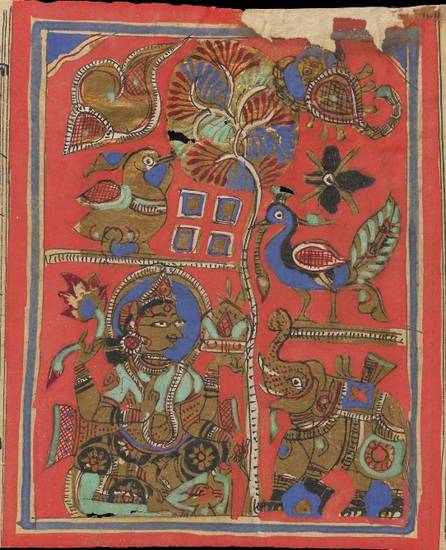
Examples of types of living beings
Image by British Library © CC0 1.0 (Creative Commons Public Domain)
During its time in the cycle of birth, the soul is reborn in different conditions depending on the karma gathered in various lifetimes. There are four conditions or mode of rebirth – gatis:
- human being – manuṣya-gati
- god or heavenly being – deva-gati
- animal or plant – tiryag-gati
- infernal being – naraka-gati.
Living beings are also classified by the number of senses they have. The single sense of touch is the most basic and is found in the simplest form of life – nigoda – and other beings that exist in elements such as fire, water, air and earth. Human beings, gods and hellish beings have five senses
The more advanced a soul’s spirituality, the more senses its body has during this birth or lifetime.
Non-violence
The most important Jain principle is ahiṃsā. Usually translated into English as ‘non-violence’, ahiṃsā is thus often understood as ‘doing no deliberate violence’. A more accurate translation of the Jain concept might be:
- ‘doing no harm, whether deliberate or accidental’
- trying to actively achieve whatever is required to protect living beings by restraining oneself.
It underlies the other principal beliefs and is the foundation of Jain religious practices. The vows of Jain mendicants and lay people are based on ahiṃsā, which forms the first of the five ‘fundamental vows’.
Jains must take care to avoid violent thoughts, speech or behaviour. Harming other living beings, even accidentally, creates karma that attaches to the soul, obscuring its purity and hindering its liberation. Avoiding injury to all living beings, which are all interconnected, is therefore vital to spiritual development. Deliberate violence is the worst kind but carelessness can also damage or kill living beings. This explains why carefulness and self-awareness are two of the key elements of being a perfect lay Jain or ideal mendicant, since these qualities minimise accidental violence.
Detachment
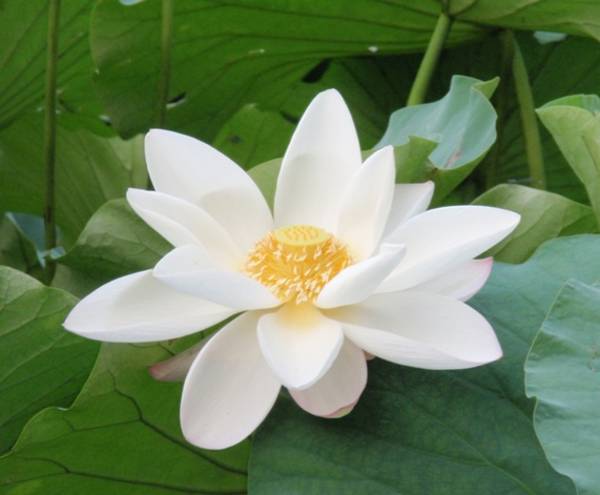
White lotus
Image by Haha169 © public domain
This is an important aim in practising the Jain faith because karma is generated by passions – kaṣāyas – or emotions, among other things. Being in a permanently calm condition free from passions, and thus karma, is a crucial stage in spiritual development. Passions are created by attachment to the world so spiritual progress requires utter detachment from the world.
When Jains renounce the lay condition to become monks and nuns, they detach themselves from all aspects of life in the world. This includes family relationships and concern for the physical body, such as tasty food, desire for warmth, comfort and personal cleanliness and the instinct to avoid or stop pain.
Jains who remain householders cannot achieve this level of detachment because they have duties to family and community. But they can work within these limits to progress spiritually. For example, they can attempt to avoid developing feelings of attachment to material things. The fifth aṇu-vrata formalises the idea of setting limits on material possessions, so that lay Jains can practise a degree of detachment.
Reading
- That Which Is: Tattvārtha Sūtra
Umāsvāti / Umāsvāmi - translated by Nathmal Tatia
Sacred Literature series
International Sacred Literature Trust in association with Harper Collins; London, UK; 1994
- Jain Cosmology
Colette Caillat and Ravi Kumar - translated by R. Norman
Bookwise (India) Pct. Ltd; New Delhi, India; 2004
- Commentary on Tattvārtha Sūtra of Vācaka Umāsvāti
Pandit Sukhlalji - translated by K. K. Dixit
L. D. series; volume 44
L. D. Institute of Indology; Ahmedabad, Gujarat, India; 1974
- Cosmology Old & New: Being a modern commentary on the fifth chapter of Tattvārthādhigama Sūtra
G. R. Jain - Jñānapīṭha Mūrtidevī granthamālā: English series; volume 5
Bhāratīya Jñānapīṭh Publication; New Delhi, India; 1991
- Karma and Rebirth in Classical Indian Tradition
Wendy Doniger O’Flaherty - University of California Press; Berkeley, California, USA; 1980
- ‘Colours of the Soul: By-Products of Activity or Passions?’
Kristi L. Wiley - Philosophy East and West
edited by Kim Skoog
volume 50: 3
University of Hawai'i Press; 2000
- ‘The Colours of the Soul and the Origin of Karmic Eschatology’
Erik Af Edholm - On the Meaning of Death: Essays on Mortuary Rituals and Eschatological Beliefs
edited by Sven Cederroth, Claes Corlin and Jan Lindström
Uppsala Studies in Cultural Anthropology series; volume 8
Upsaliensis Academiae; Uppsala and Stockholm, Sweden; 1988
- Gender and Salvation: Jaina Debates on the Spiritual Liberation of Women
Padmanabh S. Jaini - University of California Press; Berkeley, California, USA; 1991
- ‘Ahimsa and Compassion in Jainism’
Kristi L. Wiley - Studies in Jaina History and Culture: Disputes and Dialogues
edited by Peter Flügel
Routledge Advances in Jaina Studies series; volume 1
Routledge Curzon Press; London, UK; 2006
- Escaping the World: Women Renouncers among Jains
Manisha Sethi - South Asian History & Culture series; volume 8
Routledge Taylor & Francis Group; London, UK and New Delhi, India; 2011
- ‘Negotiating Karma, Merit, and Liberation: Vow-taking in the Jain Tradition’
M. Whitney Kelting - Dealing with Deities: The Ritual Vow in South Asia
edited by Selva J. Raj and William P. Harman
State University of New York Press; Albany, New York, USA; 2006
- ‘Fasting unto death according to the Jaina tradition’
Colette Caillat - Acta Orientalia
volume 38
Oriental Societies of Denmark, Finland, Norway and Sweden; Stockholm, Sweden; 1977
- ‘Modern Science and the Four Noble Truths of Jains’
K. V. Mardia - Young Jains International Newsletter
volume 22: 1
February to May 2008
- The Scientific Foundations of Jainism
K. V. Mardia - edited by Dayanand Bhargava
Lala Sunder Lal Jain Research series; volume 5
Motilal Banarsidass; New Delhi, India; 1996
- Many-Sided Wisdom: A New Politics of the Spirit
Aidan Rankin - O Books; Winchester, Hampshire, UK and Washington DC, USA; 2010
- Steps to Liberation: 2500 Years of Jain Art and Religion
Jan van Alphen - Etnografisch Museum Antwerpen; Antwerp, Belgium; 2000
- ‘Women and Jainism in India’
Nalini Balbir - Women in Indian Religions
edited by Arvind Sharma
Oxford University Press; Delhi, India; 2002
- ‘Observations on the sect of Jains’
Henry Thomas Colebrooke - Asiatic Researches
volume 9
1807
- Jains in the World: Religious Values and Ideology in India
John E. Cort - Oxford University Press USA; New York, USA; 2001
- The Jains
Paul Dundas - Library of Religious Beliefs and Practices series; series editor John Hinnels and Ninian Smart; volume 14
Routledge Curzon Press; London, UK; 2002
- Scripture and Community: Collected Essays on the Jains
Kendall W. Folkert - edited by John E. Cort
Studies in World Religions series; volume 6
Center for the Study of World Religions, Harvard University & Scholars Press; Atlanta, Georgia, USA; 1993
- Religion and Culture of the Jains
Jyoti Prasad Jain - Jñānapīṭha Mūrtidevī granthamālā: English series; volume 6
Bhāratīya Jñānapīṭh; New Delhi, India; 1975
- The Jaina Path of Purification
Padmanabh S. Jaini - University of California Press; Berkeley, California USA; 1979
- Collected Papers on Jaina Studies
Padmanabh S. Jaini - Motilal Banarsidass; New Delhi, India; 2000
- ‘Le Jainisme’
Olivier Lacombe - L'Inde classique: manuel des études indiennes
edited by Louis Renou and Jean Filliozat et alia
volume 2
Imprimerie Nationale; Paris, France and Hanoi, Vietnam; 1953
- ‘Une secte religieuse dans l’Inde contemporaine’
Louis Renou and Marie-Simone Renou - Études
École Française d’Extrême-Orient; Paris, France; 1951
- ‘Women and the Reproduction of the Jain Community’
Josephine Reynell - The Assembly of Listeners
edited by Michael Carrithers and Caroline Humphrey
Cambridge University Press; Cambridge, UK; 1991
- The Doctrine of the Jainas: Described after the Old Sources
Walther Schubring - translated by Wolfgang Bühlen
edited by Satya Ranjan Banerjee
Lala Sunder Lal Jain Research series; volume 15
Motilal Banarsidass; New Delhi, India; 2000
- Mahāvīra and His Teachings
A. N. Upadhye, Bal Patil and Dalsukh Malvania - volume VII: 1
Bhagavān Mahāvīra 2500th Nirvāna Mahotsava Samiti; Bombay, Maharashtra, India; 1977
- Historical Dictionary of Jainism
Kristi L. Wiley - Historical Dictionaries of Religions, Philosophies, and Movements series; series editor Jon Woronoff; volume 53
Scarecrow Press; Maryland, USA; 2004
Links
- Jain doctrine
-
Jainworld.com gives a detailed explanation of key elements of Jain doctrine, including the:
- three gems
- concept of knowledge
- lay conduct
- vows
- penance.
- Introduction to Jainism – part 3
-
This extract from a BBC documentary on Jainism called The Frontiers of Peace explores the concept of renunciation. The video follows a young woman's decision to become a nun and a rich lay man's faith. The ritual of keśa-loca is filmed, in which monks and nuns pull out their hair. The lay man is shown making the auspicious symbols of the svastika, three dots representing the 'three jewels' of right insight, right knowledge and right conduct and the horizontal crescent of the siddha-śilā, where liberated souls live. This 2010 YouTube video is the third of four parts. See the next part at: http://www.youtube.com/watch?v=670KFhISeUk
- Decorated idol of Mahāvīra surrounded by lights
-
One of the most important Jain festivals, Dīvālī takes place over several days in late September or October. Jains commemorate the final liberation of the 24th Jina, Mahāvīra. At Dīvālī, as in other festivals, statues and temples are lavishly decorated, as shown in this 2007 Flickr photograph of the statue of Mahāvīra in the Katraj temple in Pune, Maharashtra. The lights surrounding the image indicate why the festival is known as the 'Festival of Lights'.
- Śruta-pañcamī – part 3
-
This YouTube video follows the end of the first day’s events of the annual Digambara festival of knowledge – Śruta-pañcamī. First, a rite of worship before a brightly coloured rangoli – a design of coloured powder or rice symbolising joy and welcome – is performed. The lay community files past the rangoli and metal sculpture representing knowledge while monks and lay people chant a Sanskrit hymn. This song praises knowledge, omniscience, the scriptures and the goddess Sarasvatī, who embodies knowledge. Behind the rangoli piles of holy books can be seen, which have been carried in procession through the village as guides to knowledge. After the fire ritual, an inititation ceremony – dīkṣā – of a new monk, featuring keśa-loca – ‘pulling out of the hair’ – takes place before the crowd. Afterwards, they move trays of fire in circles – āratī – offering pūja or worship to the new mendicant. An anointing ceremony – abhiṣeka – of the māna-stambha pillar found in front of Jain temples follows, with a final procession past the symbols of knowledge.
This three-part YouTube video records the festival at Mudalur, Tamil Nadu in India, held over 28th and 29th May 2009. This is the final part and you can watch the first part at: http://www.youtube.com/watch?v=5S2bcehoy-U
- Maṇḍala of Mahāvīra
-
The Museum of Fine Arts in Boston, USA, provides a zoomable photograph of a 16th-century meditation diagram. This colourful maṇḍala depicts the samavasaraṇa – universal assembly – of an omniscient Jina, in which he preaches to all sentient beings. In the centre is the 24th Jina Mahāvīra, preaching to:
- members of the fourfold community in the corners
- pairs of natural enemies who are at peace during the sermon, such as the lion and antelope.
Numerous auspicious symbols and mantras enhance the powerful spiritual qualities of the maṇḍala.
http://www.mfa.org/collections/object/jain-mandala-with-varddhamana-in-the-center-22429
- Jain beliefs about the soul
-
An overview of Jain beliefs about the soul on the BBC website, provided as part of the Religions section.
http://www.bbc.co.uk/religion/religions/jainism/beliefs/soul.shtml
- Karma, passions and karmic stain
-
Jinalaya.com provides a detailed explanation of the complex doctrine of karma in the Jain faith, including the related notions of passions – kaṣāyas – and 'karmic stain' – leśyā – which indicates a soul's spiritual condition.
- Basis for the Classification of Leshya
-
HereNow4U provides an extract from Transmutation Of Personality Through Preksha Meditation that discusses the categories of leśyā or soul colour. The extract takes the form of an interview with Ācārya Tulsi, the eighth leader of the Śvetāmbara Terāpanthin sect. Although he uses scripture to explain leśyās, Ācārya Tulsi considers the concept partly in the context of the 'insight meditation' – prekṣā dhyāna – of the Śvetāmbara Terāpanthins, which may also be practised by those who do not follow this sect.
- US Congressman speaking on ahiṃsā
-
This video on YouTube shows US Congressman Dennis Kucinich giving a speech on the principle of ahiṃsā – non-violence.
- Twelve lay vows
-
Information about the 12 vows Jain lay people can take, provided by Pravin K. Shah on the website of the Jainism Literature Center, associated with the Faculty of Arts and Sciences at Harvard University.
http://www.fas.harvard.edu/~pluralsm/affiliates/jainism/jainedu/12vows.htm
- Partial English translation of pratikramaṇa
-
English translation of part of the prayer of pratikramaṇa on YouTube. One of the daily duties of monks and nuns, reciting the pratikramaṇa is a rite of confession that for lay Jains forms a key part of the annual festivals of Paryuṣaṇ and Daśa-lakṣaṇa-parvan. As part of this confession ritual, Jains say the Prakrit phrase Micchāmi Dukkaḍaṃ, meaning ‘May no harm come from my actions’. This is a formulaic apology that festival-goers are supposed to perform.
- Fasting
-
BBC Religions provides an overview of the religious practice of fasting among Jains, including the concept of fasting to death, called santhara or sallenkhana
http://www.bbc.co.uk/religion/religions/jainism/customs/fasting_1.shtml
- Parts of a siddhacakra
-
Academic K. V. Mardia has created a diagram describing the different parts of a siddhacakra or navapada. The foremost Jain yantra, the siddhacakra summarises some of the holiest elements of the Jain religion.
The Yorkshire Jain Foundation in the UK provides a downloadable and printable PDF. You will need to have Adobe Acrobat Reader on your computer to open PDF files.
- Summary of the three gems
-
The Religions section on the BBC website provides an outline of the three gems of the Jain faith.
http://www.bbc.co.uk/religion/religions/jainism/beliefs/threejewels.shtml
- Science in Jainism
-
The Indian scholar M. R. Gelra of the Jain Vishva Bharati Institute in Ladnun, Rajasthan, has written a book called Science and Jainism: Perspectives, Issues and Futuristic Trends. It is available to read online on the HereNow4U website.
eLibrary Links
- A Study of Tattvārtha-sūtra with Bhāṣya
- Volume 86 of the L. D. Series is an attempt to assess the date of the Tattvārtha-sūtra using its treatment of some doctrinal themes and references to external data. It seems reasonable to locate it in the 5th century CE. The differences between Digambara and Śvetāmbara versions of the text are also discussed, as well as the status of the Bhāṣya and the question of knowing whether it has the same author as the sūtra itself.
- +
- aAbhavya
- aAbhinandana
- aAbhiṣeka
- aĀcāra
- aĀcārāṅga-sūtra
- aĀcārya
- aAchalbhrata
- aAḍhāī-dvīpa
- aAdharma
- aAdho-loka
- aAdhyayana
- aAdvaita Vedānta
- aĀgama
- aAghātīya
- aAghātīya-karman
- aAgnibhuti
- aAgra
- aĀhāra
- aAhiṃsā
- aAhimsa Day
- aAjita
- aAjīva
- aAkampit
- aĀkāśa
- aAkbar the Great
- aAkṣaya-tṛtīyā
- aAlauddin Khalji
- aAlbert Einstein
- aAllah
- aAlms
- aĀlocanā
- aAloka-ākāśa
- aAmāri
- aAmbikā or Kūṣmāṇḍinī
- aAnagāra
- aAnanta
- aAnarthadaṇḍa
- aAnaśana
- aAnekānta-vāda
- aAṅga
- aAniconism
- aAnojjā
- aAntarāla
- aAntarāya-karma
- aAṇu
- aAṇu-vrata
- aAnukampā
- aAnuprekṣā
- aAnusvāra
- aApabhraṃśa
- aAparigraha
- aAra
- aĀrambha
- aĀrambhaja
- aĀratī
- aArdhamāgadhī Prākrit
- aArhaṃ
- aArhat
- aArśana-āvaraṇīya-karma
- aĀrta-dhyāna
- aĀryikā
- aĀryikā Jñānamati
- aĀśātanā
- aĀścarya
- aAscetic
- aAsceticism
- aAshram
- aAspiration
- aĀsrava
- aAṣṭa-maṅgala
- aAṣṭāpada
- aAstikāya
- aAstrolabe
- aAsura
- aAtheism
- aAticāra
- aAtiśayakṣetra
- aAtithisaṃvibhāgavrata
- aĀtma-vāda
- aĀtman
- aAuṃ
- aAurangzeb
- aAuspicious
- aAusterity
- aAvadhāna
- aAvadhi-jñāna
- aĀvaraṇī-yakarman
- aAvasarpiṇī
- aAvatāra
- aAvidyā
- aAxiom
- aĀyāga-paṭa
- aĀyambil
- aĀyu-karma
- aĀyurveda
- bBabur
- bBāhubali
- bBaladeva
- bBālāvabodha
- bBandha
- bBasadi
- bBazaar
- bBhadrankarvijay
- bBhagavant
- bBhaktāmara-stotra
- bBhakti
- bBhale
- bBharata
- bBhāṣā
- bBhāṣya
- bBhaṭṭāraka
- bBhāva
- bBhāva-pūjā
- bBhāvanā
- bBhavana-vāsin
- bBhavya
- bBhavyatva
- bBhaya
- bBhoga-bhūmi
- bBhogopabhoga
- bBodhi
- bBollywood
- bBrahmā
- bBrahma-deva
- bBrahmacārī
- bBrāhmaṇa
- bBraj Bhāṣā
- bBright fortnight
- bBritish Raj
- bBuddha
- bBuddhi-sagar
- bBuddhism
- bBuddhist
- cCaitya
- cCaityavāsin
- cCakravartin
- cCakreśvarī
- cCāmara
- cCandanā
- cCandragupta
- cCandraprabha
- cCanon
- cCāritra
- cCāritramohanīya-karman
- cCarũrī
- cCaste
- cCaturvidha-saṅgha
- cCaturviṃśati-stava
- cCāturyāma
- cCE
- cCelibacy
- cCha
- cChadmastha
- cChastity
- cCheda-sūtra
- cChristian
- cChristianity
- cClergy
- cCloning
- cColophon
- cCommentary
- cConch
- cConfession
- cCongregation
- cConsecration
- cCosmology
- cCremation
- cCrore
- cCult
- cCūrṇi
- dDādā-guru
- dDalit
- dDāna
- dDaṇḍa
- dDark fortnight
- dDarśana
- dDarśanamohanī-yakarman
- dDaśa-lakṣaṇa-parvan
- dDeity
- dDelhi Sultanate
- dDerāsar
- dDeśāvakāśika-vrata
- dDetachment
- dDevanāgarī
- dDevānandā
- dDevarddhi-gani
- dDevotee
- dDhamal
- dDhanuṣ
- dDhāra
- dDharma
- dDharma-dhyāna
- dDharma-sāgara
- dDharmastikaya
- dDhātakīkhaṇḍa
- dDholak
- dDhyāna
- dDiaspora
- dDig-vrata
- dDigambara
- dDīkṣā
- dDisciple
- dDīvālī
- dDivya-dhvani
- dDNA
- dDoctrine
- dDogma
- dDonor
- dDoṣa
- dDravya
- dDravya-pūjā
- dDrone
- dDuṣamā
- dDuṣamā-duṣamā
- dDuṣamā-suṣamā
- dDveṣa
- dDvīpa
- eEast India Company
- eEightfold Path
- eEkānta-vāda
- eEkendriya
- eElder
- eElders
- eEschatology
- eEtc up to
- fFarmān
- fFast
- fFatehpur Sikri
- fFestival
- fFestschrift
- fFiruz Shah
- fFly-Whisks
- fFolio
- fFour Noble Truths
- gGaccha
- gGaṇa
- gGaṇadhara
- gGanadharavada
- gGaṇeśa
- gGaṇin
- gGarba
- gGarbha
- gGarbha-gṛha
- gGaruḍa
- gGati
- gGene
- gGenomics
- gGhātī-yakarman
- gGhātīya
- gGhaznavid
- gGhiyasuddin Tughlaq
- gGhurid
- gGloss
- gGotra-karma
- gGujarāt
- gGujarati
- gGuṇa
- gGuṇa-sthāna
- gGuṇa-vrata
- gGupti
- gGuru
- gGuruṇī
- hHagiography
- hHajj
- hHaṃsa
- hHaribhadra
- hHariṇaigameṣin
- hHasta
- hHeresy
- hHiṃsā
- hHindi
- hHindu
- hHinduism
- hHīravijaya
- hHoroscope
- hHrīṃ
- hHumayun
- hHymn
- iIconoclasm
- iIconography
- iIdol
- iIndian Independence
- iIndology
- iIndra
- iIndrabhūti Gautama
- iIndriya
- iInitiation
- iIntercession
- iInvocation
- iIQ
- iIslam
- iIslamicate
- iIṣṭadevatā
- iĪśvara
- jJagat
- jJahangir
- jJain
- jJaina Devanāgarī
- jJaina Śaurasenī
- jJaina-dharma
- jJainaśāsana
- jJainness
- jJaisalmer
- jJamāli
- jJambū-dvīpa
- jJames Burgess
- jJanma
- jJanma-kalyāṇa
- jJarā
- jJāti
- jJina
- jJina-āgama
- jJina-bhavana
- jJina-bimba
- jJina-mātā
- jJinacandra-sūri
- jJinadatta
- jJinaprabha
- jJīva
- jJñāna
- jJñāna-āvaraṇīya-karma
- jJñāna-āvarṇiya
- jJñānsundar
- jJyotiṣka
- kKāla
- kKālakācārya-kathā
- kKālidāsa
- kKalpa-sūtra
- kKalpa-vṛkṣa
- kKalyāṇaka
- kKalyanvijay
- kKamaṇḍalu
- kKamaṭha
- kKarma
- kKarma-bhūmi
- kKarma-grantha
- kKarma-prakṛti
- kKarma-vāda
- kKarmon
- kKarnataka
- kKaṣāya
- kKathā
- kKāvya
- kKāya
- kKāyotsarga
- kKeśa-loca
- kKetu
- kKevala-jñāna
- kKevalin
- kKhalji
- kKharatara-gaccha
- kKnowledge
- kKriyā
- kKriyā-vāda
- kKṛṣṇa
- kKṣamā-śramaṇa
- kKṣapakaśreṇi
- kKṣatriya
- kKṣullaka
- kKulakara
- kKundakunda
- kKunthu
- lLabdhi
- lLaity
- lLakh
- lLāñchana
- lLands of Action
- lLaukāntika
- lLavaṇa-samudra
- lLeśyā
- lLiṅga
- lLinguistics
- lLoka
- lLoka-ākāśa
- lLoka-puruṣa
- lLoka-vāda
- lLotus
- lLotus lake
- mMadhya-loka
- mMahā-videha
- mMahā-vrata
- mMahābhārata
- mMahāmastakābhiṣeka
- mMāhārāṣṭra
- mMāhārāṣṭrī Prākrit
- mMahattarā Yākinī
- mMahāvīr Jayantī
- mMahāvīra
- mMakāra
- mMakkhali Gośāla
- mMalli
- mMāna-stambha
- mManaḥ-paryāya-jñāna
- mMaṇḍala
- mMaṇḍapa
- mMandit
- mMaṅgala
- mMantra
- mMantras
- mManuṣya-loka
- mMarāṭhī
- mMārgaṇā
- mMartyr
- mMarudevī
- mMaṭha
- mMati-jñāna
- mMauryaputra
- mMecca
- mMendicant lineage
- mMetarya
- mMiracle
- mMithyādṛṣṭi
- mMohandas Gandhi
- mMohanīya-karma
- mMokṣa
- mMonastic order
- mMonasticism
- mMonk
- mMonotheism
- mMosque
- mMount Meru
- mMount Sammeta
- mMṛgāvatī
- mMughal
- mMuhammad
- mMuhammad bin Tughlaq
- mMuhpattī
- mMūla-sūtra
- mMūlaguṇa
- mMumbaī
- mMuni
- mMunisuvrata
- mMurad Bakhsh
- mMūrti-pūjaka
- mMuslim
- mMysticism
- nNābhi
- nNāga-kal
- nNāgapurīya Tapā-gaccha
- nNāgarī
- nNāma-karma
- nNamaskāra-mantra
- nNami
- nNandīśvara-dvīpa
- nNandivardhana
- nNandyāvarta
- nNāraka
- nNāraki
- nNasalisation
- nNātha
- nNavrātrī
- nNaya-vāda
- nNemi
- nNidāna
- nniggaṃthāṇa vā 2
- nniggaṃtho vā 2
- nNigoda
- nNihnava
- nNikṣepa
- nNirgrantha
- nNirjarā
- nNirvāṇa
- nNiryukti
- nNiṣidhi
- nNitya
- nNiyati
- nNo-kaṣāya
- nNudity
- nNun
- oOcean of milk
- oOmniscience
- oOrdination
- ppa°
- pPadmaprabha
- pPadmāsana
- pPadmāvatī
- pPādukā
- pPalanquin
- pPalette
- pPañca-muṣṭi
- pPāṇḍava
- pPaṇḍit
- pPandit Dalsukh D. Malvania
- pPandit Sukhlalji
- pPāṇipātra
- pPāpa
- pParamātman
- pParameṣṭhin
- pPāraṇā
- pParigraha
- pPariṇāma
- pParīṣaha
- pParokṣa
- pPārśva
- pPārśvanātha
- pParyāya
- pParyuṣaṇ
- pPaṭa
- pPatan
- pPātra
- pPenance
- pPersian
- pPhala
- pPhilology
- pPicchikā
- pPilgrimage
- pPīr
- pPolymath
- pPoṣadha
- pPossession
- pPothī
- pPrabhas
- pPradakṣiṇā
- pPradeśa
- pPrākāra
- pPrakīrṇaka-sūtra
- pPrākrit
- pPramāda
- pPramukhā
- pPrati-vāsudeva
- pPratikramaṇa
- pPratimā
- pPratiṣṭhā
- pPratyākhyāna
- pPratyakṣa
- pPravacana
- pPrāyaścitta
- pPrayer
- pPre-modern
- pPreach
- pPredestination
- pProtestant
- pProvenance
- pPudgala
- pPūjā
- pPujārī
- pPukharavara-dvīpa
- pPuṇya
- pPūrva
- pPuṣkara-dvīpa
- pPuṣpadanta
- pPyre
- qQur’an
- rRāga
- rRāhu
- rRainy season
- rRajasthan
- rRajasthani
- rRājimatī
- rRajoharaṇa
- rRajput
- rRāma
- rRāmāyaṇa
- rRangoli
- rRās-garbā
- rRasa
- rRathanemi
- rRatna-traya
- rRātri-bhojana
- rRaudra-dhyāna
- rRecto
- rRelic
- rRenunciation
- rRetroflex
- rRevatī
- %Ṛg-veda
- rRite
- rRosary
- %Ṛṣabha
- %Ṛṣabhanātha
- rRupee
- sSaciyā Mātā
- sSādhu
- sSādhvī
- sSāgāra
- sSaint
- sŚaivaism
- sŚaka-saṃvat
- sSallekhanā
- sŚalya
- sSamacatuṣṭha
- sSamādhimaraṇa
- sSamaṇi
- sSāmarambha
- sSamavasaraṇa
- sSāmāyika
- sSaṃbhava
- sSamiti
- sSaṃjñā
- sSaṃkalpaja
- sSaṃsāra
- sSamudghāta
- sSaṃvara
- sSaṃvega
- sSamyak-cāritra
- sSamyak-darśana
- sSamyak-jñāna
- sSamyaktva
- sSaṃyama
- sSanctuary
- sSandalwood
- sSaṇgha
- sSanskrit
- sSant
- sŚānti
- sSapta-bhaṅgi-naya
- sSārambha
- sSarasvatī
- sSarvajña
- sSāsan-devi
- sŚāsana-devatā
- sŚāstra
- %Ṣaṭ-jīvanikāya
- sSatī
- sSatīmātā
- sSatya
- sSchism
- sScribe
- sScripture
- sSect
- sSecularism
- sŚenāī
- sSermon
- sŚeṣavatī
- sSevā
- sSeven fields of donation
- sShah Jahan
- sShantidas Jhaveri
- sShrine
- sSiddha
- sSiddha-śilā
- sSiddhacakra or Navadevatā
- sSiddhānta
- sSiddhārtha
- sSiddhi
- sSikh
- sSikhism
- sŚikṣā-vrata
- sŚīla
- sSin
- sSindh
- sŚītala
- sŚiva
- sSkandha
- sSomanatha
- sŚraddhā
- sŚramaṇa
- sŚrāvaka
- sŚrāvakācāra
- sŚrāvikā
- sŚreyāṃsa
- sŚrī
- sŚrīvatsa
- sŚruta-jñāna
- sŚruta-pañcamī
- sSthānaka-vāsin
- sSthāpanācārya
- sSthāvara
- sSthavira
- sSthiti
- sStrīmukti
- sStūpa
- sSubcontinent
- sSudarshana
- sŚuddhi
- sSudharma
- sŚūdra
- sSufism
- sSukha
- sŚukla-dhyāna
- sSulasā
- sSultan
- sSumati
- sSundarśrī
- sSupārśva
- sSūri
- sSuṣamā
- sSuṣamā-duṣamā
- sSuṣamā-suṣamā
- sSūtra
- sSuyam me ausam! Tenam bhagavaya evamakkhayam
- sSvādhyāya
- sSvāhā
- sSvastika
- sŚvetāmbara
- sŚvetāmbara Terāpanthin
- sŚvetāmbaras
- sSwan
- sSyād-vāda
- tTabla
- tTantra
- tTapā-gaccha
- tTapas
- tTāraṇ Svāmī Panth
- tTattva
- tTattvārtha-sūtra
- tTemple
- tTemple-city
- tThe Enlightenment
- tTheology
- tThree worlds
- %Ṭīkā
- tTilaka
- tTīrtha
- tTīrthaṃkaranāma-karman
- tTīrthankara
- tTransliteration
- tTrasa
- tTrasa-nāḍī
- tTriśalā
- tTriṣaṣṭi-śalākā-puruṣa-caritra
- tTti bemi
- tTughlaq
- tTunk
- uUdumbara
- uUniversal History
- uUpādhyāya
- uUpāṅga
- uUpaniṣads
- uUpāsaka
- uUpasarga
- uUpāśraya
- uŪrdhva-loka
- uUtsarpiṇī
- uUttarādhyayana-sūtra
- vVāhana
- vVaimānika
- vVairāgya
- vVaiṣṇava
- vVaiśramaṇa
- vVaiśya
- vValabhī
- vVanaspatikāya
- vVandana
- vVaṇik
- vVarṇa
- vVāsudeva
- vVāsupūjya
- vVayubhūti
- vVeda
- vVedanīya-karma
- vVegetarianism
- vVehicle
- vVernacular
- vVerso
- vVidyā
- vVidyā-devī
- vVihāra
- vVijñapti-patra
- vVikrama-saṃvat
- vVikṛti
- vVimala
- vVinaya
- vVipāka
- vVirji Vora
- vVirodhaja
- vVīrya
- vVisarga
- vViṣṇu
- vVītarāga
- vVizier
- vVotive
- vVow
- vVrata
- vVS
- vVyakta
- vVyantara
- vVyasana
- yYakṣa
- yYakṣī
- yYantra
- yYaśoda
- yYaśovijaya
- yYati
- yYātrā
- yYoga
- yYoginī
- yYojana


